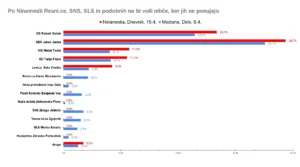By: Spletni časopis
The rise in popularity of government parties was measured by Ninamedia, led by Nikola Damjanić, in a survey for Dnevnik, but the methodology of this agency is quite unique.
Respondents are only offered a choice of five parliamentary parties, with smaller parties excluded. Due to the smaller competition, government parties garner significantly higher shares compared to Mediana’s research, conducted for POP TV and Delo, which includes a variety of smaller parties, typically diverting votes to ruling left-wing parties. According to the latest Mediana survey for Delo, several of these parties, which have no MPs, would either enter parliament or are close to the threshold. However, according to Ninamedia, all smaller parties combined would not gather enough votes to enter the National Assembly. Ninamedia (as well as other agencies) typically include a party of new faces in the line-up just before elections to boost its prospects. Prior to the last elections, this was Robert Golob’s Svoboda, and before that, Marjan Šarec’s List. The comparison of the latest Median survey for Delo and Ninamedia’s for Dnevnik is as follows:

How the popularity of the top five parties in the National Assembly fluctuates over the longer term according to various surveys, which are difficult to compare due to different questionnaires, is shown in the graph:
Dnevnik also publishes quite comical ratings of politicians, according to which Nataša Pirc Musar and Anže Logar are at the top, as they performed best in the recent presidential elections. High on the list are also Mayor Vladimir Prebilič and former president of NSi, Ljudmila Novak, who are running for European elections, and there we will see how important this rating is, as preferential votes are also possible. In fifth place is the new leader of SD, Matjaž Han.
At the bottom of Dnevnik’s ranking are European Parliament member Franc Bogovič (SLS), Asta Vrečko (Levica), and Miha Kordiš (Levica).
In the graphs and the article, the party support percentages are calculated considering only voters who have defined preferences for parties. This allows for comparison with elections and between different surveys. I consider those who choose the “other” party option as having defined preferences for a party. These are parties that are not offered to respondents (for example, the five parliamentary parties), but respondents remember them independently. The original support percentages for different parties from various surveys, as reported by the media and used as the basis for calculations, are published in a table (by clicking, you can enlarge all tables):
I provide all the data that served as the basis for the calculations because it facilitates understanding the differences between measurements and enables verification to see if there may have been errors in the transfer and processing of data.